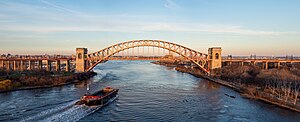
Back جسر بوابة الجحيم Arabic Хел Гейт (мост) Bulgarian Pont de Hell Gate Catalan Hell Gate Bridge German Puente de Hell Gate Spanish Hell Gate zubia EU پل هل گیت FA Hell Gate Bridge French גשר הל גייט HE Hell Gate híd Hungarian
Hell Gate Bridge | |
|---|---|
 The main span above Hell Gate | |
| Coordinates | 40°46′57″N 73°55′19″W / 40.78250°N 73.92194°W |
| Carries | Northeast Corridor and New York Connecting Railroad |
| Crosses | Hell Gate, Little Hell Gate, Bronx Kill |
| Locale | New York City; (Queens, Randall's and Wards Islands, and the Bronx) |
| Owner | Amtrak |
| Maintained by | Amtrak |
| Characteristics | |
| Design |
|
| Material | Steel |
| Total length | 17,000 ft (3.2 mi; 5.2 km) (including approaches) |
| Width | 100 ft (30.5 m) |
| Longest span | 1,017 ft (310 m) |
| Clearance below | 135 ft (41.1 m) |
| Rail characteristics | |
| No. of tracks | 3 |
| Track gauge | 4 ft 8+1⁄2 in (1,435 mm) standard gauge |
| Structure gauge | AAR |
| Electrified | 12.5 kV 60 Hz AC catenary (Northeast Corridor only) |
| History | |
| Architect | Henry Hornbostel |
| Designer | Gustav Lindenthal |
| Constructed by | American Bridge Company |
| Fabrication by | American Bridge Company |
| Construction start | 1912 |
| Construction end | 1916 |
| Opened | March 9, 1917[1] |
| Location | |
 | |
The Hell Gate Bridge (originally the New York Connecting Railroad Bridge) is a railroad bridge in New York City, New York, United States. The bridge carries two tracks of Amtrak's Northeast Corridor and one freight track between Astoria, Queens, and Port Morris, Bronx, via Randalls and Wards Islands. Its main span is a 1,017-foot (310 m) steel through arch across Hell Gate, a strait of the East River that separates Wards Island from Queens. The bridge also includes several approach viaducts and two spans across smaller waterways. Including approaches, the bridge is 17,000 feet (5,200 m) long. It is one of the few rail connections from Long Island, of which Queens is part, to the rest of the United States.[a]
The New York Connecting Railroad (NYCR) was formed in 1892 to build the bridge, linking New York and the Pennsylvania Railroad (PRR) with New England and the New York, New Haven, and Hartford Railroad (NH). A cantilever bridge across Hell Gate was proposed in 1900, but the plan was changed to a through-arch bridge after repeated delays. Construction was overseen by the engineers Gustav Lindenthal, Othmar Ammann, and David B. Steinman and architect Henry Hornbostel. The bridge was dedicated on March 9, 1917, and was the world's longest steel arch bridge until the Bayonne Bridge opened in 1931. Various proposals to modify the bridge in the 1920s were unsuccessful. The bridge was renovated in the 1990s following three decades of deterioration.
The main span is a two-hinged arch flanked by stone towers on either bank of Hell Gate. Northwest of the Hell Gate span, the viaduct is carried on plate-girder spans along the east side of Wards and Randalls Islands. A four-span inverted bowstring truss bridge, measuring 1,154 feet (352 m), carries the railroad tracks across Little Hell Gate, a former stream between Randalls and Wards Islands. Further north is a 350-foot (110 m), two-span truss bridge across Bronx Kill, a small strait separating Randalls Island from the Bronx. There are also steel-and-concrete approach viaducts in the Bronx and Queens. In addition to the three existing tracks on the bridge, there was a fourth track used by freight trains until the 1970s. The passenger tracks have been electrified since c. 1918, and the freight tracks also had electrification from 1927 to 1969. The Hell Gate Bridge has received commentary both for its design and its impact on Long Island's commerce, and its design inspired that of the Sydney Harbour Bridge.
Cite error: There are <ref group=lower-alpha> tags or {{efn}} templates on this page, but the references will not show without a {{reflist|group=lower-alpha}} template or {{notelist}} template (see the help page).